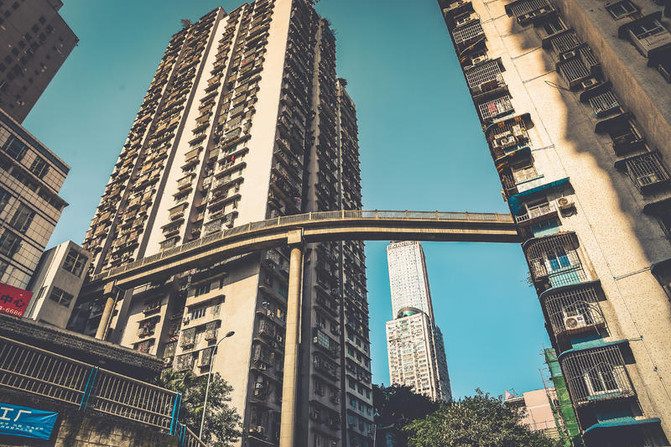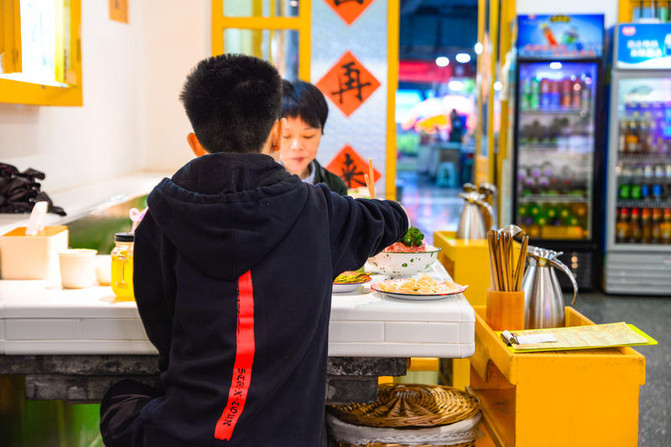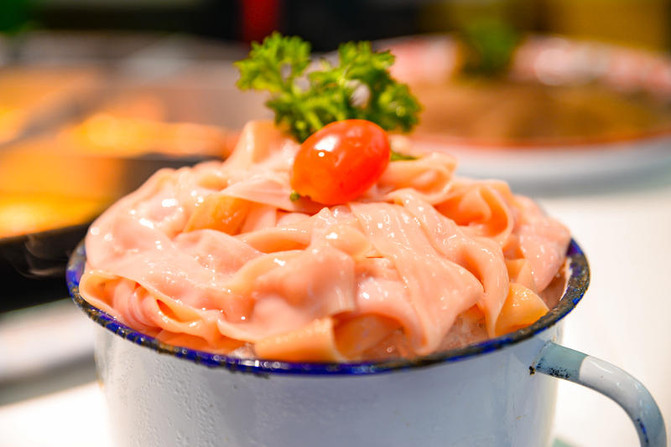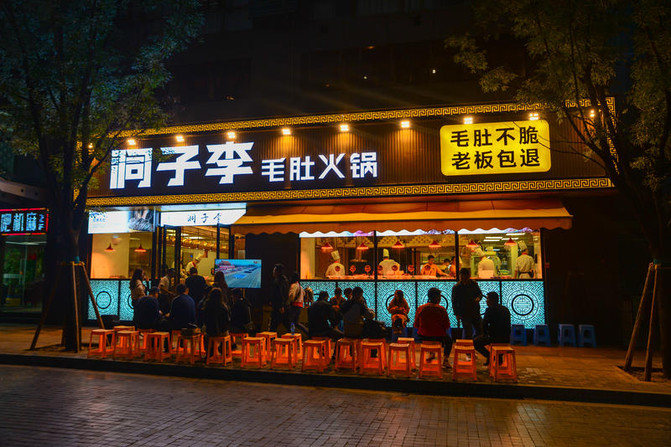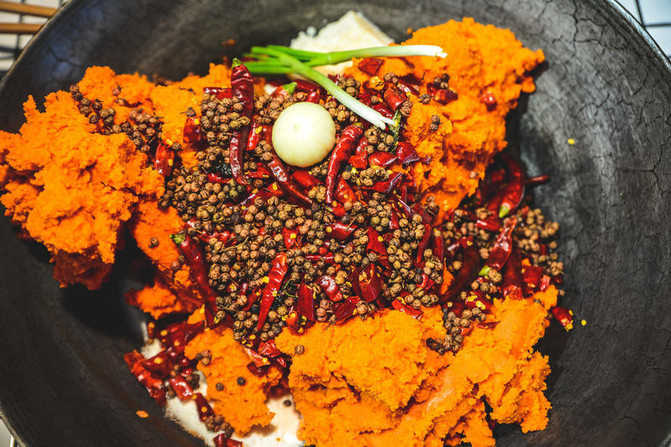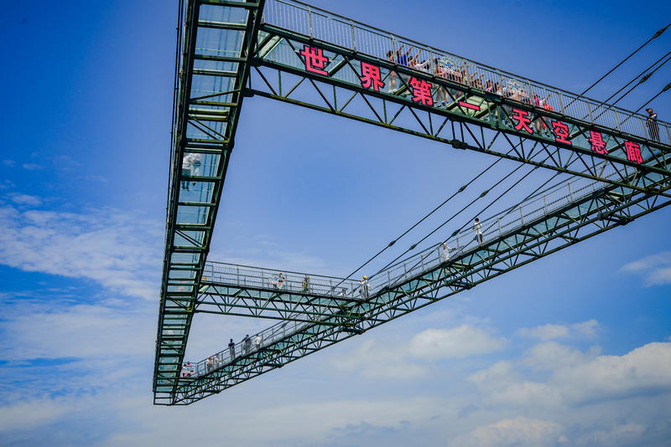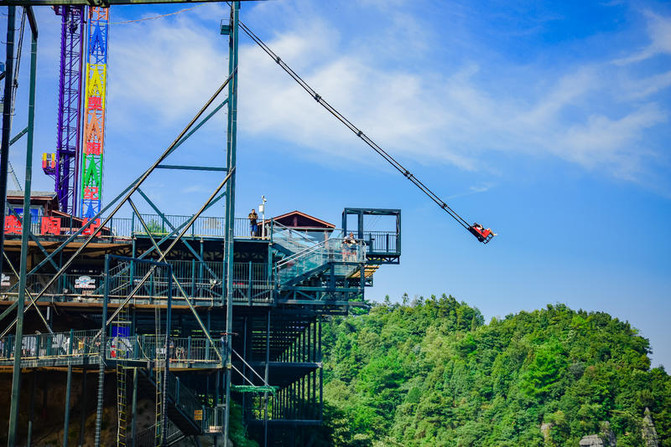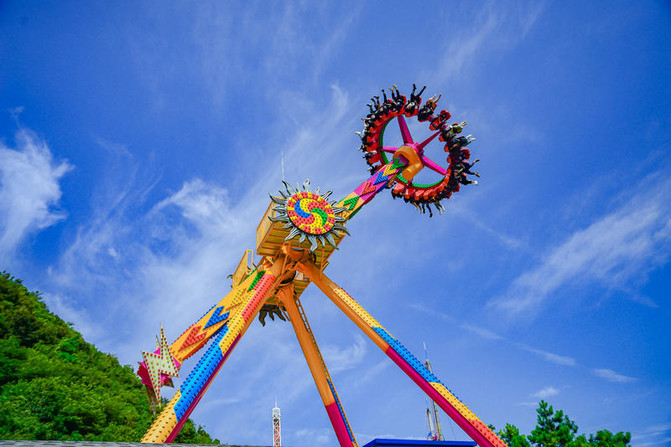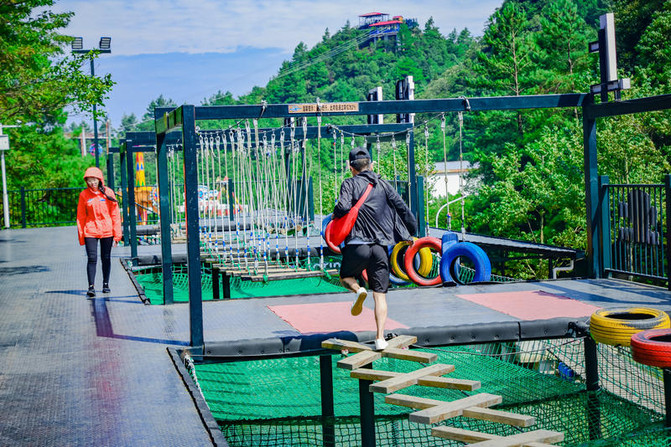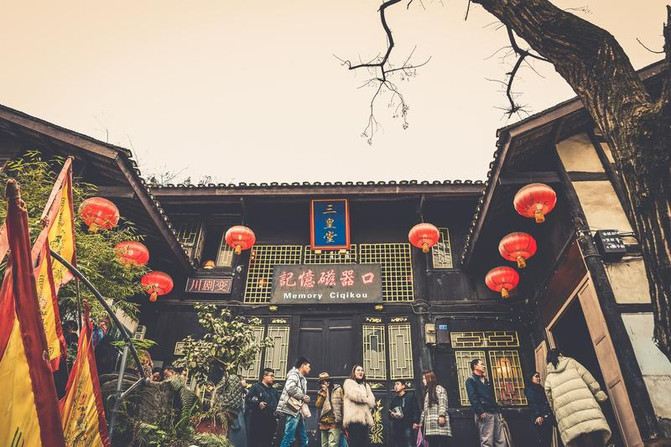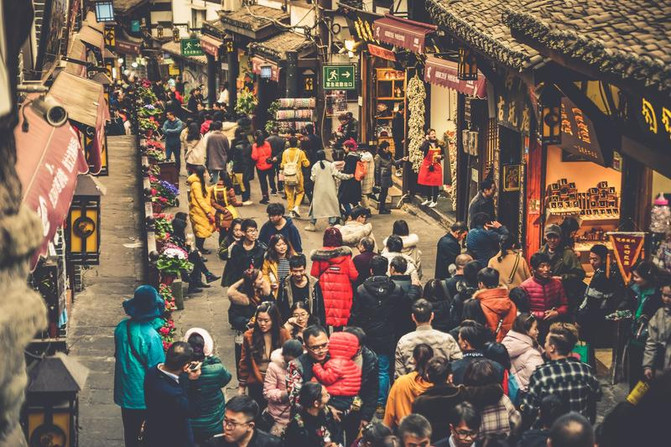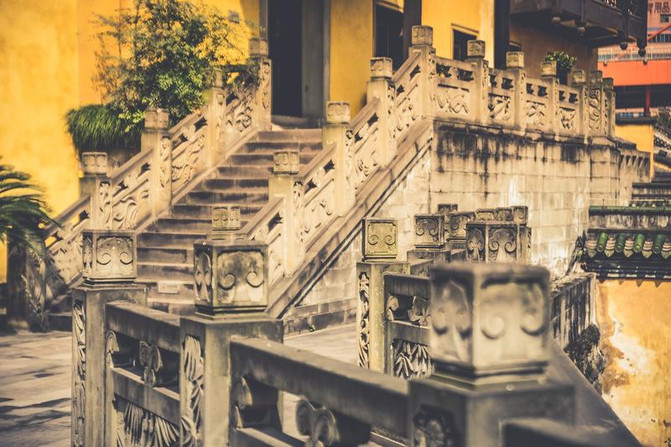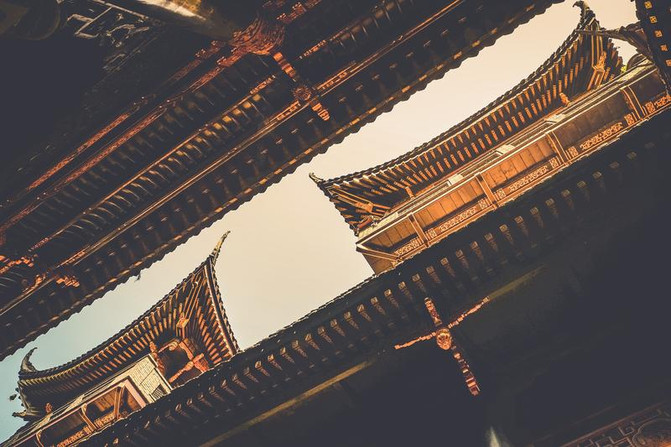Impressions of Chongqing
Coming out of the airport, Chongqing's unique features are everywhere. The sudden continuous rain streaks through the hair of the passing crowd, wetting the gray and green stone steps one by one. As the stone steps curved upwards, from a high vantage point, it presented wide roads and high-rise buildings with a strong modern urban flavor. The charm of Chongqing lies in its perfect blend of bustling city traffic, nightlife, and local cultural traditions and customs, without leaving any stiffness or stubbornness. It still has its own vitality and once again marvels at its magic. Roads and light rails can shuttle quickly through high-rise buildings. And walking out of a high-rise building with three, four, or even a dozen floors on a flat road is a unique sight that other cities cannot replicate.

At night, standing on the observation deck, looking around, the night view of the mountain city is presented in all directions before your eyes. Chongqing faces the river on three sides, with one side leaning against the mountains and building a city against them. The buildings are layered and the roads spiral upwards. The bustling city streetlights, bridge lights, and all kinds of civilian lights form a sea of lights that are arranged in a staggered and complementary manner, with vehicles and ships shuttling through the vast sea of lights, adding a touch of vitality. Jiang Huizhao, a famous poet who was an official of Fengjie Supervisor of the County County in the Qing Dynasty, described in his poem "Yu Shui Xiao Deng" that "thousands of lanterns shine on the river and the word Ba shines on the sky all the time. Who planted the Yuhe Star calendar, with golden waves and silver trees shining brightly together. The sky is filled with stars like human lights, and the sky is filled with colorful lights like the stars of the Milky Way, like fire trees and silver flowers, like jade buildings. The night view of the mountain city exudes a natural charm.

The ancient porcelain mouth, bluestone wooden houses, and gray tiles, with ancient charm passing through the smoke and clouds of history, slightly weathered but fully displaying the prosperity of the present world, attract tourists to shop or visit the past.
Walking through the overpasses of urban blocks, crossing over the new bridges on the river, the architectural complex of Hongyadong is built along the cliffs of the river bank, with red and yellow wooden carvings that are solemn and quaint.
Chongqing is charming and magical, with winding banks along the river and towering buildings cascading in a magnificent manner. Sometimes it reaches the sky, but later it reaches the riverbank. The winding road winds through the valleys of buildings, creating a unique mountain city that is both heavenly and earthly.
Chongqing Flavor
The magnificent night view and the lively and beautiful girls on the streets form a sharp contrast with the cultural life of the common dock. The local people play mahjong in fluent Chongqing dialect, sit around the street stalls to heat hot pot, and squat on the roadside with a bowl of hot and sour noodles or small noodles to satisfy their hunger. This city grows up amidst both hardship and kindness, full of contradictions and possibilities. Its prosperity, boldness, and atmosphere all speak to its unique character. Most outsiders' impression of Chongqing also starts with its cuisine, and the most representative of Chongqing is hotpot. Coming to Chongqing, besides wandering around various popular tourist attractions every day, my favorite thing is the fragrant spicy flavor that fills the room.
Cuisine ⑴ Boiled Youth Hot Pot
Youth is an expired ticket that never waits
Youth is a fleeting cloud that never looks back
Youth is an old hotpot that lingers and dissolves in red soup~
The first taste of Chongqing cuisine - "Boiled Youth Hot Pot" shop is located at No. 114 Minzu Road, next to Heping Building, 440 meters away from the Xiaoshizi subway station. Near Hong Monument to the people's Liberation and Bayi Road Delicious Street. This store is one of the online celebrity food stores in the Monument to the people's Liberation business circle.
The store is not large in scale, but it is exquisitely decorated with a clear theme. The entire interior decoration is in the style of the 1980s, especially the classic old songs played in the store, which can evoke full memories of youth.
I ordered a red soup pot with a nine grid base. His pot base is very good, and without cooking for a long time, there is a very rich and spicy flavor wafting out. Cloud tripe, Banhua fat beef, and fresh fish paste are essential ingredients.
Cuisine ⑵ Dongzi Li Mao Du Hot Pot
Mao Du: Everyone loves to make fun of me, up and down, nine seconds down. Maodu and hotpot are a perfect match, and almost every hotpot restaurant in Chongqing serves Maodu, with Dongzi Li Maodu hotpot being one of the best made dishes.
The second dish of Chongqing cuisine, Dongzi Li Mao Du Hot Pot, is located at Building A, No. 19 Datong Lane, Yuzhong District, Chongqing. As this restaurant is very close to my rented homestay and only a ten minute walk away, I arrived at the restaurant at 6 pm in the afternoon. At this time, the queue outside had already started to pick up numbers.
Goose sausage, duck blood, and kidney flower are the most popular soup ingredients in the store. We strongly recommend the specialty kidney flower, which is dipped in the store's unique dry dishes. The taste is indescribably delicious, salty and delicious, with a slight spiciness.
The signature of the store is definitely tripe. As long as you order tripe, there will be a dedicated chef to tear it off on site, and the tripe is soaked in mineral water and ice cubes, making it more refreshing and crispy in taste. So it's in line with the slogan in the store, 'The belly is not crispy, the boss guarantees a refund'~
Cuisine ⑶ Local Jiugong Ge Lao Hot Pot
The third dish of Chongqing cuisine - Chongqing local old hotpot. This is an authentic Chongqing Jiugongge hotpot restaurant located at 75 Cangbai Road. Across from the store is Starbucks on the first floor above Hongyadong, which is particularly easy to find.
When I went there, it was raining because I had to leave Chongqing on my last day and brought my luggage. The waiter in the store came over warmly to help me drag my luggage. The overall feeling of the restaurant is that of the old Chongqing style, with a clean and tidy environment. Although the decoration is done in an old-fashioned style, sitting down still feels very stylish.
I ordered a slightly spicy red pot, although it was slightly spicy, the bottom of the pot still felt a bit domineering. I ordered handmade hand copied dishes, slaughterhouse tripe, Nanchuan rice field frog, bowls of fresh duck blood, and handmade fish roe shrimp paste.
The variety of seasonings on the seasoning table is very rich. Personally, I prefer the combination of garlic paste and sesame oil. I tried adding a little oyster sauce, which made my mouth dry even better. Molten tripe can usually be eaten after 10 seconds of boiling, as it tends to harden if cooked for too long. Fish roe and shrimp roe are very fresh, and besides tripe, shrimp roe is my favorite.
Dreamy Ordovician
The Dreamy Ordovician located in Wansheng, Chongqing is one of the recently popular online tourist attractions, with the world's longest suspended glass corridor holding the Guinness World Record. I saw many pictures of this glass corridor online and was instantly planted with grass. On my first day in Chongqing, I headed straight to the Dreamy Ordovician Scenic Area.
It takes about two and a half hours to drive from downtown Chongqing to the Dreamy Ordovician. In order to have more activities to play in the scenic area (there are indeed many attractions in the scenic area, about 60, which cannot be completed in one day, it is recommended to arrange a two-day tour before going, so that you can have more time and experience each project well), I woke up early in the morning and arrived at the scenic area at around 9am.


The scenic area has two main gates, the main gate and the west gate. After entering from the main gate, there are two roads on the left and right sides. According to the map of the scenic area, the Sky Hanging Corridor is located at the end of this road on the left side of the main gate, which is the west gate of the scenic area. I came specifically for the Sky Hanging Gallery, so I decided not to look for any fun experience projects on the right side of the main entrance and headed straight towards the direction of the Sky Hanging Gallery.


You can take the direct train from the middle gate to the west gate of the scenic area, which is very convenient for round-trip travel. In fact, it is not far to walk from the middle gate to the west gate. There is a No. 4 high-altitude zip line project in the middle that you can experience. The advantage of entering the scenic area early is that you don't have to wait in a long line to play anything. From the opposite side of the zip line slide, you are not far from the west gate. Below the zip line is a dinosaur world built in a one-to-one ratio. Sliding over from a certain angle, it looks like you are about to fly into a dinosaur's mouth, which is very interesting.
There are many small food shops at the west gate, offering a wide variety of specialty snacks with different flavors. Entering from the west gate, this area is mostly a children's entertainment zone with younger ages, featuring entertainment projects such as self controlled airplanes and carousels.



However, the most obvious one is undoubtedly the huge and exciting sky hanging corridor from any angle. On May 19, 2017, the Ordovician sky hanging corridor successfully applied for the Guinness World Record and became the world's longest suspended glass corridor, hanging on a cliff several hundred meters high and extending more than 80 meters in the air along the cliff, hence the name sky hanging corridor. The corridor bridge is shaped like an "A" and covered with fully transparent glass, gradually narrowing from the inside out. Standing at the top of the corridor bridge, not only does it give you a magnificent view of the mountains and stunning sky scenery, but it also subverts your perception of high-altitude excitement.



On both sides of the sky hanging corridor are U-shaped glass cloud covered bridges and terrifying 21 meter long cliff swings. It really requires great courage to go up and experience, but there are quite a few people eager to try it out. A long queue formed early in the morning. Next to the terrifying swing, walking up the fully transparent glass steps, is another exciting and fun entertainment machine - the Cliff Three Heroes. Flying high in the sky, jumping off cliffs, and screaming on cliffs can all make you scream repeatedly and feel satisfied.
After playing the projects in the Ximen area, take the scenic area direct train and pass through the Zhongmen to reach the final station. Extreme water challenge, 360 ° pendulum, rocket bungee jumping, performance bar, pirate ship, each one ignites the whole body's sports nerves.
If you're coming with friends, jungle jumping is definitely not to be missed. The Ordovician Scenic Area has created a total of 6 unique and creative jungle jumping routes, allowing you to experience the thrill of extreme sports firsthand! Tie up the safety rope, shuttle between tall trees and suspension bridges, challenge your limits, and challenge yourself.
Don't miss out on the performance of the Ordovician style theater - Party Space. This is a newly opened theater in the Ordovician period. During the day, there are performances such as cute animals and exciting magic shows. Tourists who are tired from the experience can go in and sit down, watch the show while resting. (There are small drinks, various beverages, and snacks to order inside, with a high cost performance ratio)
Party Space's performance at night is a complete nightlife style, just like the bars on Ninth Street. The LED screen on the stage inside is extremely large, paired with colorful and dazzling spotlights, making it possible for anyone inside to transform into a trampoline athlete. Moreover, there are professional bartenders performing, offering a wide range of beers, cocktails, and foreign liquors. On the nights of the Ordovician period, enjoy a small drink and join the crazy DJs in the fun! Let this sleepless night be filled with endless joy!

In fact, the entertainment projects in the entire Ordovician scenic area are far more than just these, such as glass suspension bridges, dreamy ice sculpture kingdoms, cold ice caves, step by step thrills, etc. Even the high-altitude zip line has 5 lines, and the high-altitude swing is divided into 21 meters, 18 meters, 8 meters, 6 meters, and 4 meters. There are countless fun projects that cannot be played in one day, let alone the specific travel routes if you come here for the first time. It is recommended to take a scenic guide map in advance and arrange it as a two-day trip as much as possible. During these two days in the Ordovician, you can also dance in the performance bar, see the sunrise, sunset, and starry sky on the edge of the Ordovician cliffs. Such two days are simply not perfect, too fulfilling.
Ciqikou Ancient Town
The first stop upon arriving in Chongqing is Ciqikou Ancient Town, an old city in Chongqing with rich historical and cultural heritage. Ciqikou is an extremely important part of Chongqing's historical and cultural city. The Ba Yu culture, religious culture, Sha Ci culture, Hongyan culture, and folk culture gathered here each have their own characteristics.
By taking the Light Rail Line 1, you can directly reach Ciqikou Ancient Town from the center of Yuzhong District. After exiting the light rail, you can walk down a snack street in the direction with a lot of people to directly reach the entrance of the West Gate.
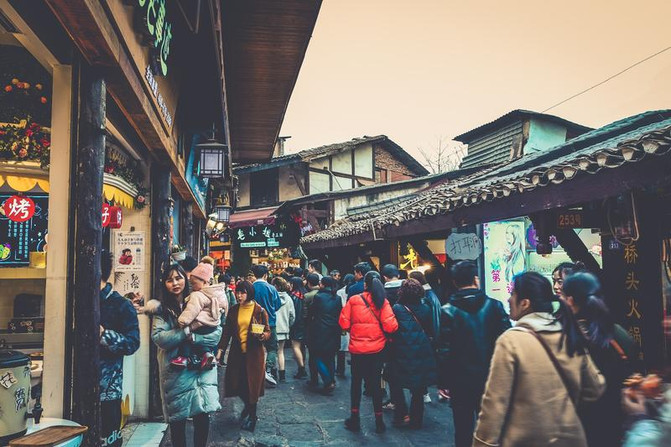
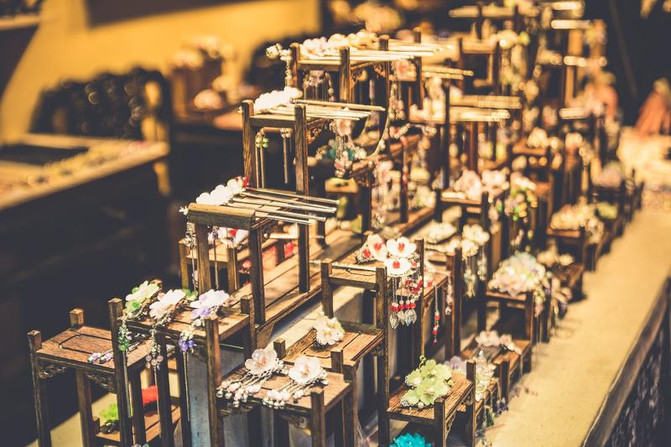


A stone road, a thousand year old magnet mouth. Ciqikou, which has been around for 1800 years, is known as the first ancient town in Bayu and has preserved relatively complete ancient buildings. The ancient town has a rustic and rugged Ba Yu heritage, tea houses that still retain ancient styles, and a dock culture that has been passed down through history; There are nine palaces and eighteen temples where Buddhism, Taoism, and Confucianism coexist; There is a site of righteous Red Rock heroes fighting against Japan; There are unique Sichuan opera singing and fire dragon performances, traditional tourism products with unique craftsmanship and diverse varieties, and famous food treasures such as Maoxuewang, Qianzhangpi, and salt and pepper peanuts.
It takes about 2 hours to walk along the stone road to get out of the ancient town, and there is a bus stop and subway station not far from the exit.
Chongqing Huguang Guild Hall
The Chongqing Huguang Guild Hall is located on the banks of the Yangtze River at Dongshimen in Yuzhong District, Chongqing. It is a collective term for the early Qing Dynasty ancient building complex and the antique new building complex, including the Guangdong Institute, Qi'an Public Office, and Yuwang Palace. It is currently the largest known ancient guild hall building complex in the central urban areas of China. From the Dongshuimen Yangtze River Bridge, you can have a bird's-eye view of the entire Huguang Guild Hall. In front of us, the Yangtze River flows eastward, and behind us, there are buildings that have remained silent for over 300 years. Standing quietly, the once mottled smoke and clouds, the once dazzling glory, the once endless prosperity, and the indescribable vicissitudes are all walking gracefully today.


The relief carving of the guild hall building is extremely exquisite and lifelike. Its main themes include patterns of characters and stories such as Journey to the West, The Story of the Western Chamber, Investiture of the Gods, and the Twenty Four Filial Piety, as well as patterns of dragons, phoenixes, animals, and various exotic flowers and plants. The entire ancient architectural complex features exquisitely carved railings and painted buildings, representing the architectural art of southern China during the Ming and Qing dynasties. It is also the largest existing ancient guild hall complex in China. In the area around Dongshimen, according to feng shui theory, the inner side of the curved river is a "auspicious place" and the outer side is a "inauspicious place". The Dongshimen area happens to be the place where the Vermilion Bird dances, with good feng shui, and the clubhouse is located here.

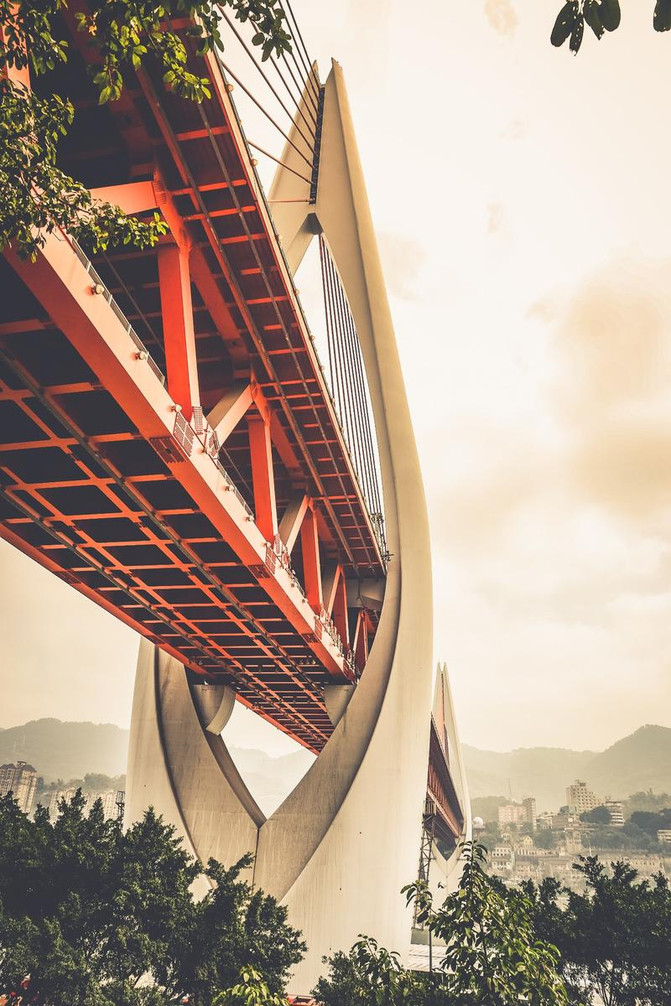
There are stops for taking the light rail or bus at Huguang Guild Hall, but it seems that the bus stop is closest. The subway entrance of Huguang Guild Hall is near the Dongshimen Bridge, and it is located below the Dongshimen Bridge. Walking to the main entrance requires a large detour. There is a ticket counter at the entrance, and adult tickets are 30 yuan per ticket.
Entering the Huguang Guild Hall, the first thing that catches the eye is the Yuwang Palace. To the left of the Yuwang Palace is China's first immigration themed museum - the Huguang Filling Sichuan Immigration Museum. Against the backdrop of "Huguang Filling Sichuan", the museum showcases the political background, economic factors, and routes of immigrants entering Sichuan from different perspectives, fully reflecting the history of "Huguang Filling Sichuan".


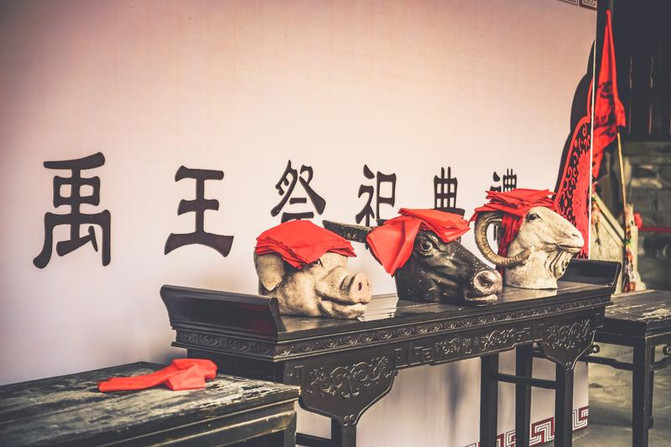


Next is the Qi'an Public Office, which is the best preserved building in the complex with a construction area of approximately 1600 square meters. The Qi'an Public Hall is a hall built by immigrants from Huangzhou Prefecture, Hubei Province. It was first built during the Jiaqing period of the Qing Dynasty. The entire building includes a theater, a courtyard, a viewing hall, a holding hall, a main hall, etc. The gate slopes eastward, facing the direction of the immigrants' hometown of Huangzhou Prefecture, Hubei Province. It not only emphasizes feng shui, but also embodies the immigrants' homesickness for their ancestral homeland.








Passing through the Qi'an Public Office, one enters the Guangdong Public Office with the four characters "Lingnan Guanzhan" left on the door. The Ming and Qing Dynasty buildings, all in color, are carved with the stories of characters from "Twenty Four Filial Piety," "Journey to the West," and "Investiture of the Gods," as well as mountains, waters, flowers, and birds. The quaint and grand architecture, as well as the lifelike carvings, showcase the former prosperity and brilliance of this ancient guild hall complex, which has a history of nearly 300 years and is the largest existing in China.



The entire Huguang Guild Hall has a spacious and magnificent architectural space, with more structural characteristics of Huizhou style architecture. At the same time, it also has distinct regional architectural characteristics of Chongqing. The entire guild hall is built along the mountain terrain, with different heights and a staggered layout. The stairs are winding, and each courtyard has a courtyard and balcony, which are features that traditional Huizhou style building structures do not have.
The architecture of Huguang Guild Hall often adopts the technique of Jiangnan style gardens in landscaping. The tall fire sealed walls between the courtyards of the guild hall divide it into several small courtyards, each of which is connected by a small door, and the space is constantly interrupted. In this way, each courtyard has its own unique function and style, which is the combination of the characteristics of Jiangnan gardens and the Huizhou architectural structure.
The decoration of Chongqing Huguang Guild Hall also has a strong Huizhou style, with wood carvings from the Huizhou wood carving series in southern Anhui. The lines are depicted as flowing clouds and water, and the figures are lifelike, including humans, ghosts, gods, flowers, birds, and animals, all of which are exquisite.



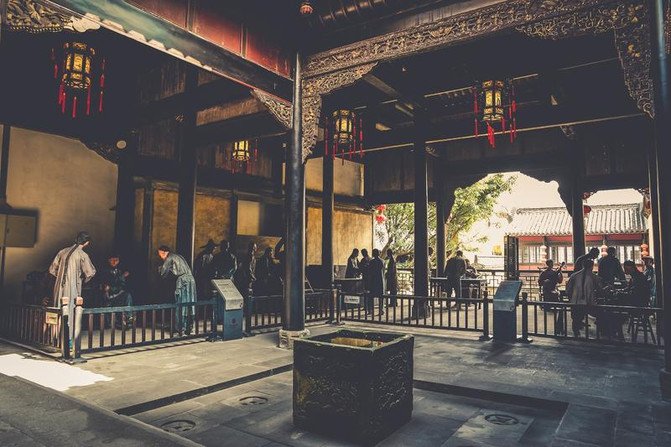



In addition, there are four ancient and elegant stages in the guild hall, including two in the Yu Palace, one in the Qi'an Public Office, and one in the Guangdong Public Office. The carvings on the stages are very exquisite, and the themes of the carvings mainly come from the character stories in "Journey to the West", "The Story of the Western Chamber", "Investiture of the Gods", and "Twenty Four Filial Piety", as well as various animal patterns such as dragons and phoenixes, and plant patterns such as exotic flowers and grasses. The craftsmanship is exquisite, lifelike, and exquisite, making it a representative work of southern architectural art in the Ming and Qing dynasties of China.
[Arhat Temple]
Arhat Temple, a thousand year old temple, is located in the most prosperous city center of Chongqing. Surrounding, there are dozens of high-rise buildings, such as Intercontinental Hotel and Oriental Manhattan, whose names alone are full of modern atmosphere. In front of the door, there is a bustling flow of people. Modern and traditional, trendy and rustic, restless and peaceful, just separated by a wall.

Arhat Temple was built in the Zhiping period of the Northern Song Dynasty (1064-1067), formerly known as Zhiping Temple. The temple was built because of Luohan Cave. According to Records of Scenic Spots in Sichuan, "Zhiping Temple... has Arhat and Xiantian two caves, all of which are ancient caves." The 20 meter long ancient Buddhist rock in Arhat Temple contains more than 400 statues of Buddha carved on rocks in the Song Dynasty, including the reclining Buddha's Nirvana (commonly known as "sleeping Buddha"), Avalokitesvara and the figure of the donor, which are quite similar in style to the Dazu Baoding Mountain stone carvings.



Chinese wise and virtuous individuals have always advocated for inner peace and non action, and have elevated themselves to the status of 'being rooted in the human realm, with a heart far away and self biased'. However, looking at the great hermits of all dynasties, their so-called "concealment" is only a strategy of retreat or a temporary way of licking wounds, or a trick to avoid the sharpness of opponents and maintain their own strength. But the believers who worship Buddha in Arhat Temple have never planned to advance or retreat between the morning bell and the evening drum, and the ancient Buddha, which has remained unchanged for thousands of years.
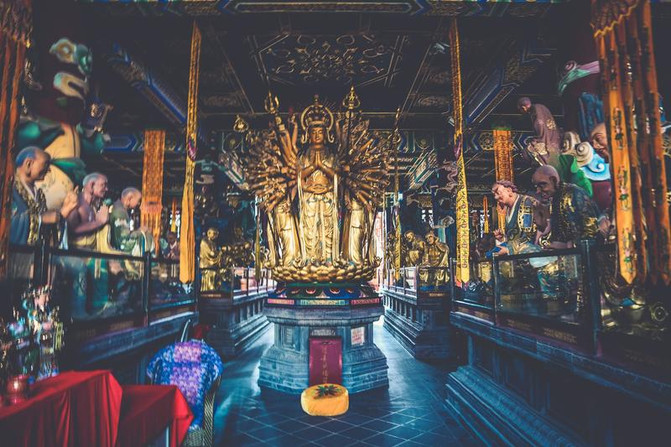
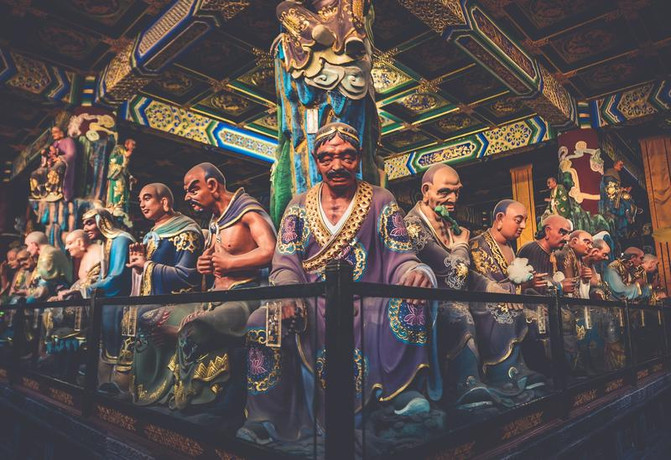
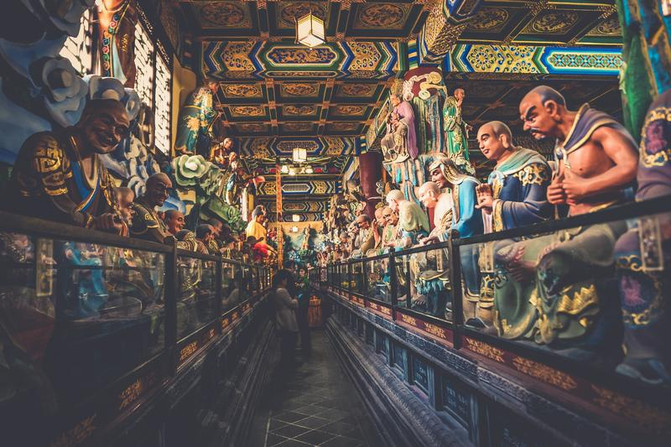

The bell rang from time to time in the deep of the temple. Although the bell of "Dangdang" did not ring as loud as the bell of other famous mountains and ancient temples, it could penetrate every corner of Arhat Temple. In front of the the Shakya ManiHall, incense sticks are in full bloom, and the smoke is curling up, which is peaceful.
Nanbin Park
Chongqing Nanbin Park is located along the Yangtze River on Nanbin Road in Nan'an District, close to residential homestays. Crossing the road leads to the park area of Nanbin Park. This is an open belt park. The park starts from the south end of Chaotianmen Bridge in the east and ends at the south end of Shibanpo Yangtze River Bridge in the west. The entire park takes green as its life, culture as its soul, and lighting as its feature, making it a new type of riverside park with historical, cultural, and Ba Yu cultural characteristics.
Across from Nanbin Park is the bustling Yuzhong Peninsula, where many people visit the riverbank every day. Nearby are many high-end luxury hotels and homestays.




